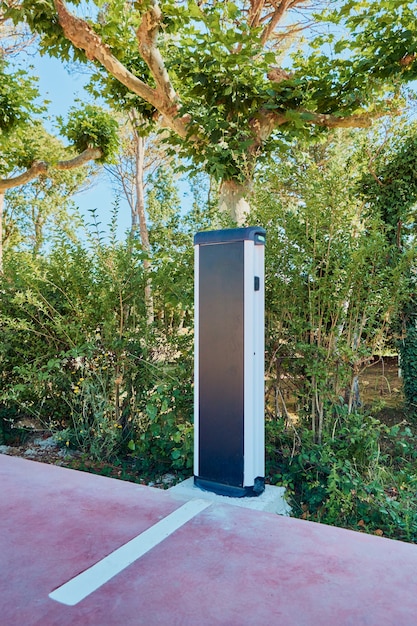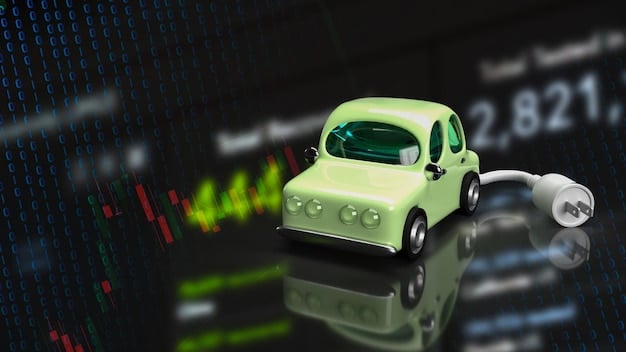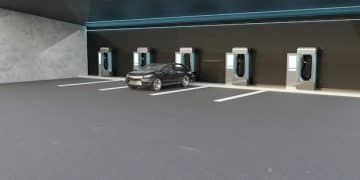Electric Vehicle Sales Soar: US Adoption Jumps 40% in Last Quarter

The US electric vehicle (EV) market is experiencing a significant upswing, with recent data revealing a remarkable 40% increase in EV adoption during the last quarter, signaling a major shift in consumer preferences and the automotive industry landscape.
The electric vehicle sales surge: latest data shows a 40% increase in electric vehicle adoption across the US in the last quarter, indicating a major turning point in the automotive industry. This remarkable growth reflects a growing consumer interest in sustainable transportation and the increasing availability of compelling EV models.
Understanding the Electric Vehicle Sales Surge
The recent 40% surge in electric vehicle adoption across the US is a noteworthy event that demands a closer look. Several factors contribute to this impressive growth, ranging from changing consumer attitudes to advancements in EV technology and supportive government policies.
Consumer Preferences and Environmental Awareness
One of the primary drivers behind the EV sales surge is the growing environmental awareness among consumers. More people are recognizing the impact of traditional gasoline-powered vehicles on air quality and climate change, leading them to seek cleaner alternatives.
- Increased awareness of climate change and air pollution.
- Desire to reduce personal carbon footprint.
- Growing appreciation for the environmental benefits of EVs.
This shift in consumer mindset is not just a trend but a fundamental change in how people perceive transportation. EVs are no longer seen as niche products but as viable and responsible choices for everyday use.

Technological Advancements and Cost Reduction
Another crucial factor contributing to the EV sales surge is continuous advancements in EV technology. Battery technology has improved significantly, leading to increased range and faster charging times, addressing two major concerns of potential EV buyers.
Furthermore, the cost of EV batteries has been steadily decreasing, making EVs more affordable and competitive with traditional gasoline-powered vehicles. Combined with government incentives and tax credits, the total cost of ownership for EVs is becoming increasingly attractive.
In conclusion, the electric vehicle sales surge is driven by a combination of environmental consciousness, technological improvements, and economic incentives, marking a significant shift in the automotive market.
Government Incentives and Policies Supporting EV Adoption
Government incentives and policies play a vital role in accelerating the adoption of electric vehicles. Both federal and state governments have implemented various measures to encourage consumers and businesses to switch to EVs.
Federal Tax Credits and Rebates
The federal government offers tax credits to consumers who purchase new EVs, providing a significant financial incentive. These tax credits can substantially reduce the upfront cost of buying an EV, making it more accessible to a broader range of consumers.
State-Level Incentives and Regulations
In addition to federal incentives, many states offer their own rebates, tax credits, and other incentives to promote EV adoption. Some states also have regulations in place, such as zero-emission vehicle (ZEV) mandates, that require automakers to sell a certain percentage of EVs.
- Rebates and tax credits offered by individual states.
- Zero-emission vehicle (ZEV) mandates.
- Investment in public charging infrastructure.
These state-level initiatives not only help reduce the cost of EVs but also create a supportive ecosystem for EV adoption. Investment in public charging infrastructure, for example, makes it easier for EV owners to charge their vehicles on the go.
Government support is essential for overcoming barriers to EV adoption and creating a sustainable transportation system. By providing financial incentives and implementing supportive policies, governments can accelerate the transition to electric vehicles and reduce greenhouse gas emissions.
In summary, government incentives and policies are key drivers of the electric vehicle sales surge, making EVs more affordable and accessible while promoting a cleaner transportation future.
Impact of Charging Infrastructure on EV Sales
The availability and reliability of charging infrastructure significantly impact the adoption of electric vehicles. A robust charging network is essential for alleviating range anxiety and making EV ownership convenient and practical.
Public Charging Stations and Accessibility
The expansion of public charging networks is crucial for supporting the growing number of EVs on the road. Public charging stations provide EV owners with the ability to charge their vehicles when they are away from home, whether they are traveling, working, or running errands.
Accessibility is another important aspect of public charging infrastructure. Charging stations should be located in convenient and easily accessible locations, such as shopping centers, workplaces, and highway rest stops. This ensures that EV owners can easily find a place to charge their vehicles whenever they need to.
Home Charging Solutions and Benefits
While public charging is important, most EV owners primarily charge their vehicles at home. Home charging offers several advantages, including convenience, cost-effectiveness, and the ability to charge overnight.
- Convenience of charging overnight at home.
- Lower electricity rates during off-peak hours.
- Availability of home charging equipment incentives.
Many EV owners install Level 2 chargers at their homes, which provide faster charging speeds compared to standard Level 1 chargers. Some utilities also offer incentives and rebates for installing home charging equipment, further reducing the cost of EV ownership.
In conclusion, the development of both public and private charging infrastructure is essential for sustaining the electric vehicle sales surge. A reliable and accessible charging network makes EV ownership more practical and appealing to a wider range of consumers.
The Role of Automakers in the EV Sales Surge
Automakers play a critical role in driving the electric vehicle sales surge. Their investments in EV technology, development of new EV models, and marketing efforts are essential for increasing consumer awareness and demand.
Investments in EV Technology and Manufacturing
Major automakers are investing billions of dollars in EV technology and manufacturing, signaling their commitment to the electric vehicle market. These investments are driving innovation in battery technology, electric drivetrain systems, and vehicle design.
New EV Models and Market Segmentation
The increasing availability of new EV models is another key driver of the sales surge. Automakers are introducing EVs in various segments, including sedans, SUVs, trucks, and vans, catering to a wider range of consumer preferences and needs.
- Expanding range of available EV models.
- Introduction of EVs in popular vehicle segments like SUVs and trucks.
- Focus on performance, design, and technology features.
By offering EVs in popular vehicle segments, automakers are making electric vehicles more appealing to mainstream consumers. The focus on performance, design, and technology features further enhances the attractiveness of EVs.
In summary, automakers are essential players in the electric vehicle sales surge, driving innovation, expanding model options, and increasing consumer awareness and demand through significant investments and strategic marketing efforts.
Consumer Demographics and EV Adoption Trends
Understanding consumer demographics and EV adoption trends is crucial for predicting future growth and tailoring marketing strategies. Electric vehicle adoption varies across different demographic groups and regions of the country.
Age, Income, and Education
EV adoption tends to be higher among younger, more educated, and higher-income individuals. These consumers are often more environmentally conscious and willing to pay a premium for sustainable transportation options.
However, as EV prices continue to decline and more affordable models become available, adoption is expected to broaden to include a wider range of income levels and age groups. Government incentives and tax credits also play a role in making EVs more accessible to a broader audience.
Regional Variations in EV Adoption
EV adoption also varies significantly across different regions of the US. States with strong government incentives, supportive policies, and well-developed charging infrastructure tend to have higher EV adoption rates.
- Higher adoption rates in states with strong government support.
- Variations in charging infrastructure availability.
- Influence of local environmental concerns.
For example, California has consistently been a leader in EV adoption, thanks to its aggressive ZEV mandates, generous incentives, and extensive charging network. Other states, such as Washington, Oregon, and Massachusetts, are also seeing strong EV growth.
In conclusion, understanding consumer demographics and regional variations in EV adoption is essential for stakeholders in the electric vehicle industry. By targeting specific demographic groups and focusing on regions with high growth potential, automakers and policymakers can further accelerate the transition to electric transportation.
Future Outlook for Electric Vehicle Sales in the US
The future outlook for electric vehicle sales in the US is bright, with continued growth expected in the coming years. Several factors will contribute to this growth, including technological advancements, declining battery costs, and increasing government support.
Projected Growth Rates and Market Share
Industry analysts project that electric vehicle sales will continue to grow at a rapid pace in the US, with EVs expected to account for a significant share of new vehicle sales by the end of the decade. Factors such as increasing consumer awareness, declining EV prices, and stricter emissions regulations will drive this growth.
The market share of EVs is projected to increase substantially as automakers introduce more EV models and consumers become more comfortable with electric vehicle technology. The shift towards electric transportation is expected to accelerate as the benefits of EVs become more widely recognized.
Potential Challenges and Opportunities
Despite the positive outlook, there are also potential challenges that could impact the growth of the EV market. These include supply chain constraints, availability of raw materials for batteries, and the need for continued investment in charging infrastructure.
- Addressing supply chain constraints and raw material availability.
- Investing in charging infrastructure to support EV growth.
- Overcoming consumer concerns about range and charging times.
However, these challenges also present opportunities for innovation and investment. Companies that can develop sustainable supply chains, improve battery technology, and expand charging infrastructure will be well-positioned to capitalize on the growing demand for electric vehicles.
In summary, the future of electric vehicle sales in the US is promising, with continued growth expected in the coming years. By addressing potential challenges and leveraging opportunities for innovation, the electric vehicle industry can pave the way for a cleaner, more sustainable transportation future.
| Key Point | Brief Description |
|---|---|
| 📈 Sales Surge | 40% increase in US EV adoption last quarter. |
| 💰 Incentives | Government policies boost affordability via tax credits. |
| 🔋 Infrastructure | Charging network expansion supports EV convenience. |
| 🚗 Model Variety | More EV options cater to diverse consumer needs. |
FAQ
▼
The surge is due to increased environmental awareness, government incentives like tax credits, and advancements in battery technology that improve range and reduce costs, making EVs more attractive to consumers.
▼
Federal and state governments offer tax credits and rebates, which significantly lower the initial cost of purchasing an EV. These incentives make EVs more affordable, encouraging more people to switch from gasoline vehicles.
▼
A robust charging network alleviates range anxiety and makes EV ownership more convenient. Accessible public charging stations and efficient home charging solutions are crucial for supporting the growing EV market.
▼
Automakers invest in EV technology, develop new EV models across various segments, and market these vehicles to increase consumer awareness. Their efforts are essential for expanding the EV market and meeting diverse consumer needs.
▼
The outlook is positive, with projections indicating continued rapid growth. Technological advancements, declining battery costs, and increasing government support are expected to drive further adoption. Challenges include supply chain constraints and infrastructure needs.
Conclusion
The recent 40% surge in electric vehicle adoption across the US signifies a pivotal moment in the automotive industry. Driven by environmental awareness, technological advancements, supportive policies, and increased model availability, the EV market is poised for continued growth and will play a crucial role in shaping a sustainable transportation future.





